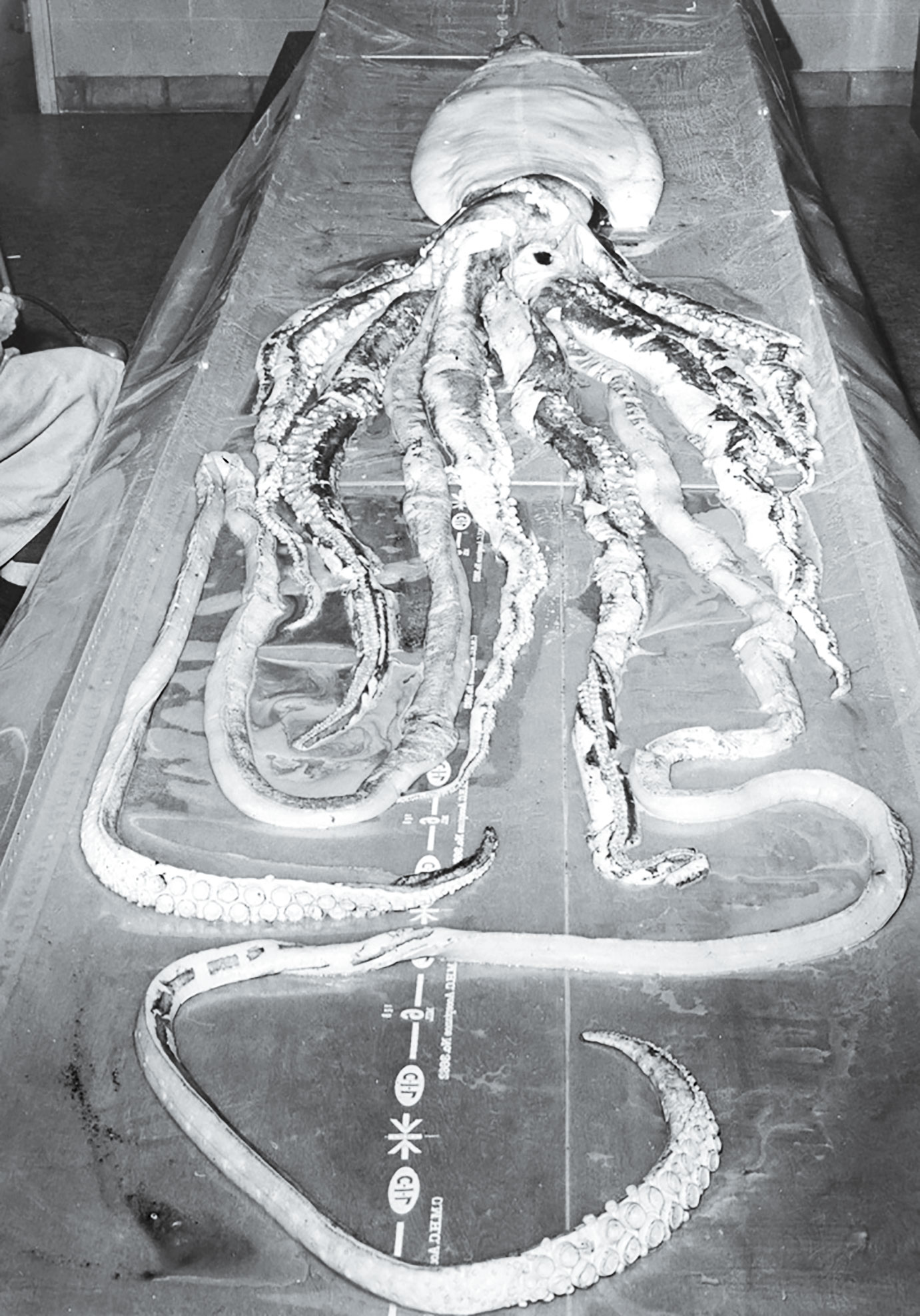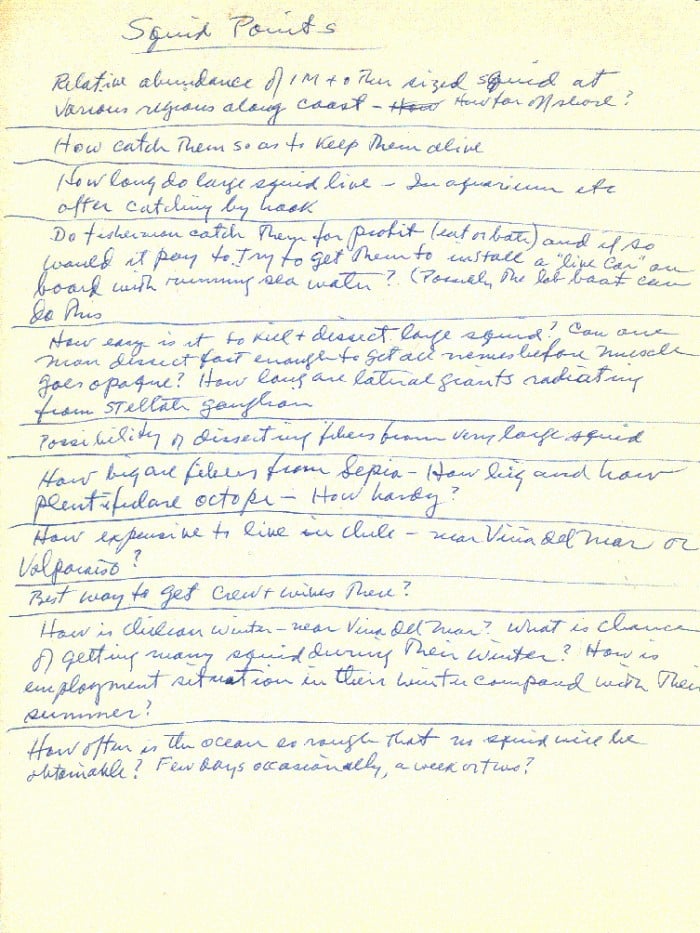Squid quest

Frank Schmitt needed more squid. Though progress continued to inch forward at the “squid club,” as his MIT biology lab was affectionately called, there never seemed to be enough squid to get everything done.
“I hope you will pardon me as I take the liberty of writing you again concerning our problem of obtaining large quantities of axoplasm from the giant fibers of the large squid,” he wrote in 1959, in his second letter to a zoology professor in New Zealand, after the first had gone unanswered. “I am bending every effort to explore every possible source.”
Schmitt, by that time an Institute Professor at MIT and renowned for his expertise in applying electron microscopy to biology, had been rounding up squid from wherever he could find them since 1936. For scientists seeking to understand the basic function and structure of nerves, squid had proved to be a nearly ideal specimen. The nerve fibers of squid are up to 20 times larger than those in humans, making them easier to isolate and examine.
These giant nerve fibers conduct electrical impulses that give squid the ability to propel themselves through the water with great speed. Schmitt and his colleagues wanted to learn how this electrical energy was produced and transmitted through the body. Their primary goal was to characterize the chemical composition of proteins within the axoplasm, a gel-like substance inside the nerve fibers.
Schmitt started studying squid while working at Washington University in St. Louis in the 1930s. He spent time in the summer at the Marine Biological Lab in Woods Hole, Massachusetts, where he procured his squid off the coast of Cape Cod. In 1941, he was recruited to MIT by President Karl Compton to head the Department of Biology and make the Institute a world center for the study of molecular biology. After World War II, he dove back into studying the biophysical and biochemical characteristics of nerve cells and set about establishing a supply of squid via the docks of Sakonnet Point in Rhode Island.

That operation was led by a young doctor in his lab, Betty Geren, who would later discover how a protective lining called myelin forms around neurons (see “A Late-Night Discovery,” MIT News, March/April 2014). Geren drove the “squid truck,” a pickup with a recirculating aquarium tank in the back, down to Sakonnet at around 4 a.m. every day in the summer. Going out on the water with the local fishermen, she collected live squid brought up in their catch and drove them back to MIT in the afternoon. A “squid team” waited for her in the parking lot, ready to hustle the squid into the lab, dissect them assembly-line style, and squeeze the axoplasm out of the nerves as if they were tubes of toothpaste. The operation averaged about 40 squid per day, and over one summer almost 3,000 were processed. But it wasn’t enough.
In a 1957 paper, Schmitt wrote that his lab was studying long strands of filament present in the axoplasm. He was trying to learn whether these filaments were part of the protein or a different material altogether, and hypothesized that they might tell him something about the amino acid composition of the protein. But he noted that further progress would depend on getting more squid. In an addendum, he added that he’d just gotten wind of an abundance of huge squid in Chilean waters—Humboldt squid, whose nerve fibers were almost twice as big as those of his New England specimens. He estimated he could get 25 times as much axoplasm from a single animal.

Schmitt went to great lengths to set up a new squid headquarters near Valparaiso. By the summer of 1957, with the help of local Chilean fishermen, scientists, universities, and the airline Panagra, he essentially established a trade route between Chile and Boston for frozen and freeze-dried squid axoplasm. During the summers, his lab began receiving three to four shipments per week of axoplasm from Chile. But Schmitt kept up his search.
“We would very much like to obtain the squid from a source closer than Valparaiso, Chile,” he wrote to Gordon Pike of the Pacific Biological Station in April 1959. Pike had recently written a paper in which he’d described the contents of the stomachs of whales off the coast of British Columbia. Squid were first on the list. “We can readily use the axoplasm of the order of 100 such squid per week,” Schmitt wrote.
His correspondence with Pike did not bear fruit, and his search continued. The following year, he wrote to Elizabeth Batham of the Portobello Marine Biological Station in New Zealand: “Would you be good enough to inform me whether in fact large squid are found in New Zealand waters, and, if so, whether any practical information is at hand concerning their capture?” But his persistent inquiries in New Zealand failed to produce a new supply.
Although he made several more attempts, Schmitt never managed to set up another squid operation. But as he noted in his autobiography, within a decade of his establishing the outpost in Chile, it had become possible to isolate axoplasm from the nerves of mammals. Since it was more desirable to study mammals than invertebrates, squid were no longer needed, and his search came to a close.
Schmitt moved on to study other species, but all the studying of squid in his lab produced many scientists who went on to become leaders in molecular biology. And Schmitt himself would eventually direct his research to what he considered the last frontier of science: the human brain. In 1962 he founded the Neurosciences Research Program at MIT, which helped establish neuroscience as a new field worthy of serious study.
Keep Reading
Most Popular
Large language models can do jaw-dropping things. But nobody knows exactly why.
And that's a problem. Figuring it out is one of the biggest scientific puzzles of our time and a crucial step towards controlling more powerful future models.
How scientists traced a mysterious covid case back to six toilets
When wastewater surveillance turns into a hunt for a single infected individual, the ethics get tricky.
The problem with plug-in hybrids? Their drivers.
Plug-in hybrids are often sold as a transition to EVs, but new data from Europe shows we’re still underestimating the emissions they produce.
Google DeepMind’s new generative model makes Super Mario–like games from scratch
Genie learns how to control games by watching hours and hours of video. It could help train next-gen robots too.
Stay connected
Get the latest updates from
MIT Technology Review
Discover special offers, top stories, upcoming events, and more.